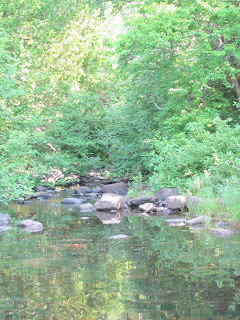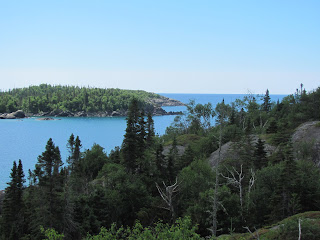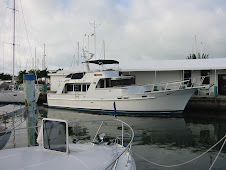Friday, August 24, 2012
August 24, 2012 - New Blogsite Notice
We have had to add a new blogsite due to capacity issues. Please go to cruisingonmonarchpart2.blogspot.com to keep up with the travels of Marty and Jerry on M/V Monarch.
Please note that this is not a link - you need to cut and past this address into your header.
Thursday, August 2, 2012
July 19 -21, 2012 - Slate Islands to CPR Slip
Our next stop is the Slate Islands, a group of eight islands about six miles in diameter, formed by the impact of a 19-mile-wide asteroid. The Slates are home to the largest herd of Woodland Caribou on Lake Superior. They were very shy, and we didn’t see them while there. Here is a link to MapQuest to show where these islands are - http://mapq.st/PstsWw
As a provincial park, the islands serve the interests of recreational boaters and fishermen. There are a few fishing camps, including the Come and Rest dock, where the fishing tug Everett H was taking the night off.
We had a difficult time finding an anchorage, as the waters were extraordinarily deep throughout the archipelago. This island bisected the entrance to Pike Bay, which might have worked except it looked incredibly narrow – can you see the pass just to the right of the island?
We opted for a spot with more room, and had a pleasant dinghy ride after getting the hook set. The mirror-calm night provided a gorgeous view of the shoreline.
Next stop is Battle Island, which gets its name from an Ojibwa skirmish during the Riel Rebellion in 1885. We anchored in the protected bay on the north side of the island, where the 15-feet deep water was so clear that we could still see (and retrieve) the screwdriver Jerry dropped overboard! A look at the charts tells us this will be the northernmost point of our entire Loop voyage, at 48°45.28' north latitude.
We found a two-track road, which we followed for about ½ mile south to a lighthouse.
The Battle Island Light was one of Ontario’s last manned lights to be automated, with no keepers needed since 1992. However, the last light keeper is still allowed to stay here from time to time, though was not in residence while we visited. Our new friend Jim from Thunder Bay told the story of one incredibly violent storm with waves so high that a huge log was washed though one of the lighthouse windows at the very top. The light is perched 118 feet high on the bluff!
Some years ago, this antique pickup must have been the light keepers work truck, now covered with moss and mold.
And along a smaller path, we found this child-size grave.
The next morning upon departure, we got an even better view of the Battle Island Light.
We had read about a perfect, tiny harbor called CPR Slip, on St. Ignace Island. In the early 1900s, this had been a Canadian-Pacific Railway fishing retreat for wealthy clients, after the harbor had been formed by removal of gravel for use in grain silos many years ago. (Here is a MapQuest link to see where this special spot is - the little hook and spit in the middle of the satellite photo is it - http://mapq.st/N1p3xp) Once we returned down the mountain, we met another couple from Red Rock, and enjoyed the evening around the fire pit.
Now CPR Slip and its 80 acres are privately owned by a Mr. Dougal from Thunder Bay. He allows locals and visitors to use the docks and property, with volunteer assistance of boaters from nearby Nipigon and Red Rock. This group of locals has built a sauna (pictured) and a community room, and maintains the property. One couple, Helgie and Judy Swanson of Red Rock, their steel boat Follow and their dog Knute are volunteer harbor hosts for most of the summer. Helgie, a hospitable Swede, came out to meet us in his rowboat, to guide us into the impossibly narrow entrance, with the channel just 9 feet off shore. We were glad to have the local knowledge and good companionship of the Swansons.
The facilities are basic.
We spotted the Canadian flag high on a bluff, and inquired about it. Helgie has cleared a trail to the top of the bluff, installed a flagpole, and directed us to the hour-long hike.
The start of the trail is through an enchanted forest.
Then, the trail steepens. No stairways here, but Helgie has installed a series of ropes with which to pull oneself up the vertical, gravel-strewn embankments.
The difficult hike was well worth the effort as we emerged upon the most extraordinary view, known locally as Harling Skorgard, which means beautiful islands in Swedish.
At the top is a guest book in a weatherproof stand. We signed in, and enjoyed reading about others who had visited this special place before us.
Way down below, we saw another boat arriving, with Helgie showing them the way into the Harbor. You can barely see Monarch secure in her slip.
Once we returned down the mountain, we met another couple from Red Rock, and enjoyed the evening around the fire pit.
Thursday, July 26, 2012
July 18, 2012 - Otter Head, Ontario
We are enthralled with the anchorages on the north shore of Lake Superior, so many to choose from and so little time! So today it’s onward to Otter Cove, an almost landlocked harbor framed by majestic bluffs, reminding us of a fjord. The cliffs towered 300 feet above this 60-foot high sailboat mast, our only neighbor for the night.
This area is part of the expansive Pukaskwa National Park. Only an abandoned shack and a little-used park warden’s cabin – complete with the pictured outhouse, are in this three-mile deep harbor. We proceeded as far into the cove as we could, anchoring across from a waterfall.
We could hear the waterfall, but even in the dinghy could not see it, as the creek was well hidden by a dense growth of trees.
The forest barely showed this tiny cabin right on the creek. Perhaps they got their running water from the hidden waterfall.
A dinghy excursion took us several miles to see Otter Island, just off Otter Head, the point that cradled Otter Cove. On the island’s north end is another harbor, called Old Dave’s, complete with an abandoned fishing camp in disrepair. This is the harbor that services the Otter Island Lighthouse, now automated. A herd of threatened (and shy, we didn’t see any) Woodland Caribou resides on this island.
Darting across to the mainland, we cruise by beautiful Cascade Falls that plunges directly into Lake Superior.
Back aboard Monarch, we weigh anchor and cruise north through the heart of Pukaskwa National Park. Established in 1983, the park encompasses some 725 square miles of incredible scenery. The rugged shoreline along the coast is stunning, with striated rock formations of contrasting colors.
In the heart of the park, we anchor in Pulpwood Harbor, aptly named for the time when logging was at its peak and 30” diameter log booms were chained or cabled together to corral smaller pulpwood for water transport. We can still see wire cables left behind on the shore. The entrance to our secluded anchorage was scarily narrow, bisected by this tiny island, and yet more than 30 feet deep! The sunset was spectacular.
In the dinghy the next morning, we set out to explore the area. While in our anchorage we were wonderfully secluded, in the next harbor north lies a 67-site campground….
….and Visitor Centre for Pukaskwa Park. This area of the park has hiking trails in easy, moderate and challenging levels (one over 37 miles long one-way), many with stairways and boardwalks to help navigate steep cliffs and wet areas.
This birch lodge is authentic to the Anishinaabe natives, who peopled the north shore of Lake Superior for generations. A First Nation interpreter kindly snapped our photo here.
We hiked several of the trails, including the Southern Headland Trail, which provided breathtaking views of the coast of Lake Superior.
At the top, we gazed out over Superior as we had a picnic lunch.
The path often took advantage of a narrow gap in the rocks.
The Beach Trail took us on Horseshoe Beach, where huge driftwood had been piled up by the prevailing westerlies.
We hiked the just-opened Manito Miikana (Spirit Trail), which had bridges over steep ravines. Here we picked wild blueberries for later use on waffles.
Flights of stairs helped us scale the nearly vertical areas of the trail. We developed quite an appetite from our miles of hiking, and satisfied this with a great meal back aboard Monarch.
Wednesday, July 25, 2012
July 13 - 15, 2012 - Into Lake Superior
This morning we departed Sault Ste. Marie as the bow of the Laker Algoma Mariner loomed large through our salon doorway. She was headed for the MacArthur Lock.
We entered the Canadian Canal Recreational Lock. This was our first transit of this lock, as last time we passed through, it was closed for repairs and we used the much larger commercial MacArthur Lock. In the distance is the International Bridge, celebrating its 50th birthday. There is lots to celebrate locally, as this year is the 100th birthday of Sault Ste. Marie, Ontario, and the 200th anniversary of the War of 1812, which saw some action nearby.
One of the most elegant lockkeepers cottages we have ever seen is right next to this lock.
Now we are in Lake Superior, so named by early explorers not because it is the largest (though it is, with a surface area of more than 31,000 square miles) in the world, nor the best (though some would argue it is) of the Great Lakes, but because it is most northerly, and at the highest elevation above sea level. We took the northern route along the Ontario shoreline, where hundreds of wind turbines provide green power for the local utility, taking advantage of the reliable westerlies.
Our night’s anchorage is in beautiful Batchawana Bay, near a provincial park of the same name. Trans-Canadian Highway 17 runs along the eastern shore here. But we couldn’t hear if from the Harmony Bay part of Batchawana Bay, a beautiful, large, protected and secluded place to set our hook. The water was an unexpected 75 degrees warm; soon, we took a refreshing swim.
The next night’s anchorage in Sinclair Cove came highly recommended, not only for its protected basin, but also for fascinating ancient rock paintings just around the corner at Agawa Rock.
Just ¼ mile from Monarch, toward the Agawa Islands are these Ojibwa pictographs, at the water’s edge beneath thirty-meter high overhanging cliffs. Visitors are able to hike here, but we took the dinghy in for a better look.
The red ochre (made from hematite and grease) paintings tell a story of a four-day canoe trip led by great Chief Myeegun from the Carp River in the Porcupine Mountains to Agawa Rock – a distance of 215 nautical miles across Lake Superior.
If you look closely, you can make out canoes, horses and maybe a caribou, or a horned and spiny reindeer. The images are about four feet tall, and date to the 1600s. They are fading as the years go by, so we were glad to see them.
We enjoyed our night on the hook here, and in the morning departed for Michipicoten Island, Lake Superior’s second largest island. The island is 40 miles from the north shore of Lake Superior, isolated and pristine. Early natives were superstitious of the island, due to its undulating appearance, sometimes disappearing in the fog. And today it did!
Along Michipicoten’s south shore we find the entrance to its most secure anchorage, Quebec Harbor, at Davieaux Island Light that is barely visible through the fog. Now automated, this light had a keeper, Gordon Dawson, who manned this remote light for 22 seasons.
Early explorers and natives valued copper deposits on the island, but these were not substantial enough to prove commercially viable. After copper, the fishing industry drew settlers to the shore, with a succession of three fish companies manning a station in Quebec Harbor. We can see the remnants of the station through a band of fog. Today, fishing tugs visit the harbor from the mainland’s Mamainse Harbor, and we see a blue and white turtleback at the dock. The buildings are in disrepair, though there are a few summer camps on the west end of the harbor.
We took up binoculars for a wildlife watch from the aft deck, and were not disappointed. We saw bald eagles, loons, black ducks, goshawks and a beaver. Over the course of the afternoon, we spotted the real highlight – more than a dozen caribou. These were introduced to the island in the 1970s, and are about the size of a small horse, with coats a mottled gray, the bucks with impressive velvet-coated antlers. A cow with a fawn-colored calf loped along the shoreline.
The peaceful setting was the perfect place for our night’s anchorage.
Subscribe to:
Comments (Atom)


















































